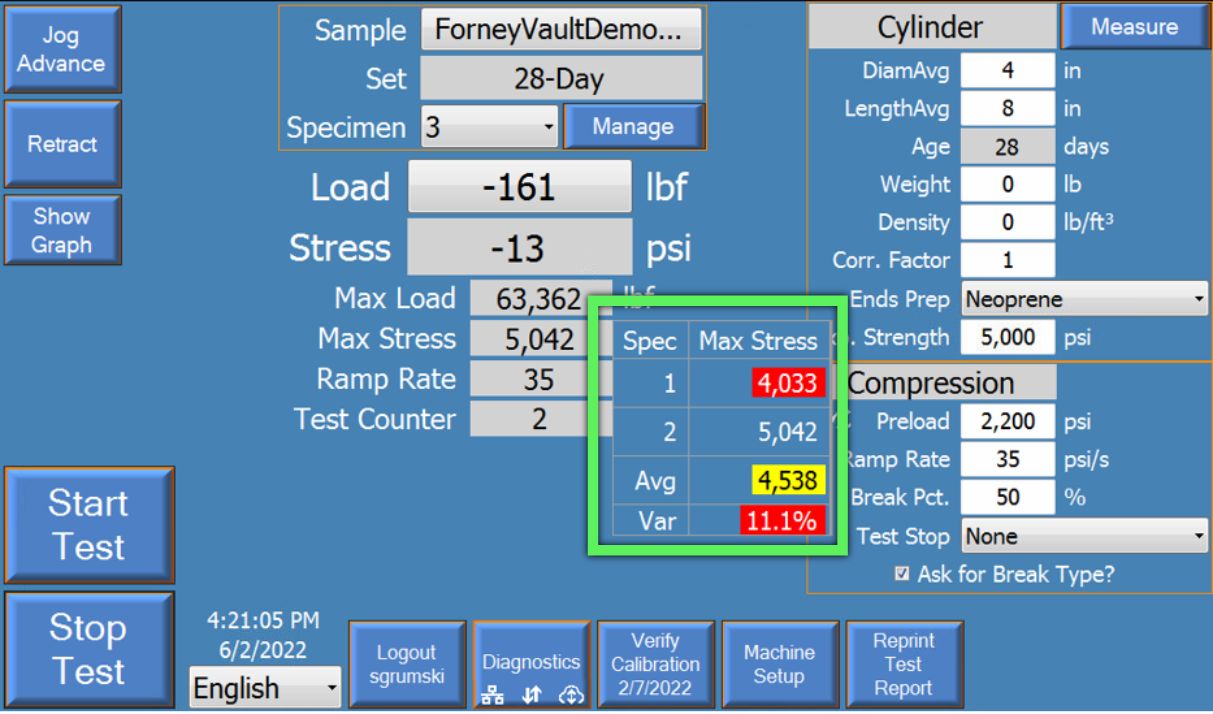Concrete strength data is only as reliable as the process and machine used to test the concrete specimen. Is your CMT machine as reliable as it can be? If these 5 problems sound familiar, it might be time for an upgrade.
For years, automatic machines have been the new standard in construction materials testing. With automatic specimen preloading, rate adjustments, and real-time data recording, automatic machines promise unparalleled testing speeds and accuracy compared to their manual counterparts.
But automatic CMT machines alone don’t solve every problem you could face in the testing workflow.
Enter: Connected CMT machines.
What Is a Connected CMT Machine?
A connected CMT machine offers all the benefits of automatic testing plus a native integration with CMT software. Here’s how this integration works:
ForneyVault | Integrated Machine Explainer from ForneyVault on Vimeo.
Most importantly, this is a two-way integration, before and after the test occurs.
Before testing, connected machines provide “Smart Checks” based on preloaded sample and specimen data. The machine:
- Validates sample date and specimen geometry, size, type, and expected strength.
- Calculates preload settings.
- Prevents incorrect specimen identification.
After testing, connected machines automatically transfer data to your LIMS package, QC system, or other software of choice.
READ MORE: 3 Reasons Why You Need More Than Just an Automatic CMT Machine
But that’s not all. Here are five other problems a connected CMT machine will help you solve, ensuring higher levels of reliability across the entire concrete testing process.
5 CMT Machine Problems a Connected Machine Solves
1. Clipboards, Comparisons & Calculations
With an automatic CMT machine, operators don’t have to record test results by hand. Instead, the machine allows results to be printed or exported to a USB drive. However, this is limited to a snapshot of the most recent test.
Only a connected CMT machine keeps all results in context. With a “digital clipboard,” machine technicians not only can compare specimens from the same sample but also calculate the average strength and variance of that sample. This history of specimens and early comparisons and calculations allow you to catch any potential problems as soon as possible.

2. Individual Low Breaks
Under ACI standards, a low break is defined as an average of two 6” x 12” cylinders’ or three 4” x 8” cylinders’ compressive strengths that are more than 500 psi below the design or specified strength. A low break is a major red flag that could indicate a problem with the concrete in use. However, a low break could also be an outlier caused by factors outside of the true strength of the concrete mix. These factors could include:
- Improper handling of the specimen
- Curing conditions
- Cylinder preparation
Either way, it’s important to be notified of an individual low break as soon as possible. A connected machine will alert you of a low individual break so you can improve your test process reliability and get ahead of any problems with the test set.
RELATED READING: How to Test a Concrete Cylinder’s Compressive Strength (ASTM C39)
3. Test Procedure Variance
One of the goals of construction material testing is to minimize variance in concrete quality. Excessive variance indicates less reliability in the test sample, leading to inconsistencies in structural integrity and overall project quality and safety.
The problem is, certain manual tasks can introduce even more variance in the results. Things like specimen identification, preloading and rate adjustments are up to the machine technician – and every technician is different with their own skill level. A connected CMT machine removes the chance for technicians to bring their own variance to the results through things like:
- Bar code scanning for positive specimen identification
- Automatic preloading calculations
- Automatic rate adjustments
4. Smart Checks
Mistakes can happen at the machine during the test set up process.
For example, selecting a ramp rate that’s too high. A faster ramp rate means the force is applied more rapidly, which can affect the material being tested. A connected CMT machine can alert the technician if the ramp rate selected is too high.
Another example is the use of a correction factor, which is an ASTM defined correction for specimen size to ensure representative test results. If you’re supposed to have a correction factor and you don’t, the machine will warn you.
Finally, a connected machine can flag measurements that seem out of line with ASTM standards. For example, if a technician enters an erroneous measurement like 40.1 instead of 4.01, the connected machine knows that measurement is outside expected variance, displays an error, and doesn’t allow the test to proceed until corrected.
RELATED READING: Other Alerts & Notifications Your Machine Can Tell You
5. Calibration Expiration
Machine calibration ensures the accuracy of your testing. When machines operate the way they’re supposed to, it produces consistent results.
Without regular calibration, testing equipment may produce inaccurate results, threatening the quality and safety of construction products.
Connected CMT machines alert machine technicians about upcoming calibration expirations. These automated notifications reduce the chances of busy lab technicians overlooking machine maintenance and ensure ultimate test reliability.
Conclusion
Connected CMT machines take automatic testing to the next level by notifying you of these common workflow issues and more. This helps technicians get ahead of problems faster and ensure tests are as reliable as possible.
Get the quality, precision and dependability you know and love in Forney testing machines, now with Connected controls. Get a connected machine quote here.
